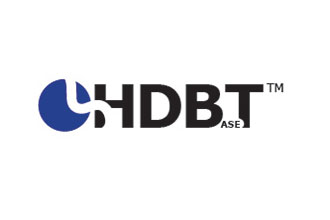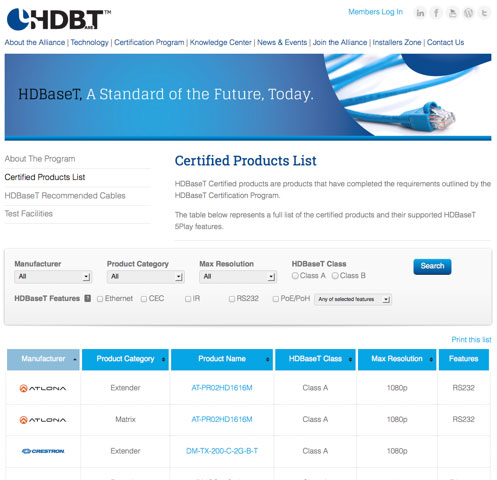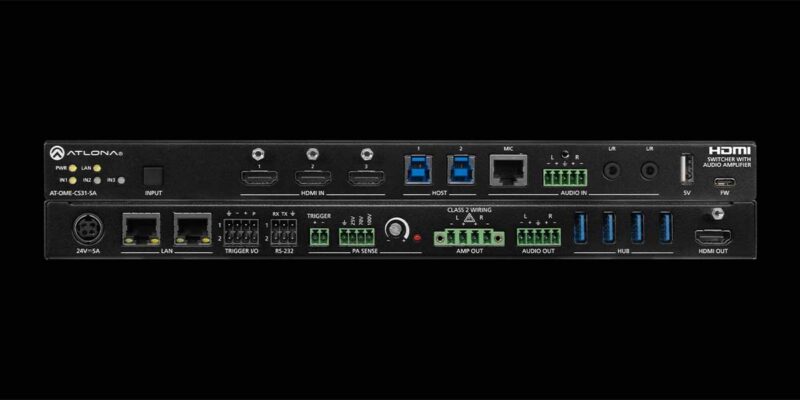HDBaseT: A Standard-Less Standard
 I’ve been a fan since the first time I heard about and read the so-called HDBaseT standard. Here’s a system that’s spec’d to send video, audio, control, Ethernet and power (marketed by the HDBaseT Alliance as “5Play”) over a Cat5e or Cat6 cable.
I’ve been a fan since the first time I heard about and read the so-called HDBaseT standard. Here’s a system that’s spec’d to send video, audio, control, Ethernet and power (marketed by the HDBaseT Alliance as “5Play”) over a Cat5e or Cat6 cable.
Perfect, huh?
It is, when it’s done right — and that isn’t often.
And, you’re all about to see how and why as you start to integrate more and more HDBaseT products from everyone from Crestron to Gefen to AMX, to Atlona to Kramer to Extron. Oh, and did I mention Sony and Panasonic and LG and Samsung and Epson?
More than 100 manufacturers of AV gear — both consumer and professional — have signed up to build HDBaseT capable products to make integration life easier (yeah, right).
Here’s the problem:
HDBaseT is simply awesome. But, truth is, the HDBaseT Alliance itself isn’t monitoring compatibility or performance at all. Not one single bit. In fact, the so-called 5Play doesn’t even have to be 5Play at all. For example, the get a product HDBaseT “approved” you only really have to do 2Play (video and audio) — I don’t even see 2Play on the Alliance’s website. Why? There’s no such thing.
Assuming all you care to send down the wire is video and audio (and assuming the manufacturer built its product well — remember, there is no performance measurement verification by the HDBaseT Alliance such that in order to be compatible with the standard), then you’ll be fine in MOST applications. But, need to send RS232, IR, IP control, Ethernet or Power across HDBaseT — good luck with that!
Well, many, many manufacturers don’t do 5Play — in fact, from what I can tell in talking to and looking at over 100 product specifications over the past week, most of them only do video, audio and IR. Most don’t do IP control, RS232 and nearly none of them do power.
Speaking of power, that’s another crap-load of problems. You see, the HDBaseT “standard” allows for what it calls PoH (Power over HDBaseT) and it’s even based on the popular, but actually measurable standard known as PoE – Power-over-Ethernet. But, PoH includes two different classes of products — one that supplies power and one that sends it — think HDBaseT transmitter and receiver applications. Logical, right? Wrong! In fact, you can buy an HDBaseT transmitter and receiver from MOST of the companies that make them and they neither will supply power to the other — it’s illogical. You see, those transmitters and receivers are assuming you’ll use something like an HDBaseT matrix switcher in the middle that’s expected to supply power too. So, if you do use a transmitter/receiver, you’ll need to plug them both into power. That’s stupid.
The HDBaseT Alliance website specifically touts 5Play as capable of delivering video (and now even 4K video with so-called “standard 2.0”) up to 100 meters over a single Cat5e/6 cable. It goes on to say that 5Play supports audio (and HDMI-quality audio too, 100 Mbps Ethernet, control that includes IR, USB, RS232, CEC and IR as well as IP control and up to 100 watts of power). Bullshit.
This may very well be the “standard” and is promoted as such on the HDBaseT website, but, truth is, that’s not what MOST products that are branded or marketed as HDBaseT products do. MOST ONLY DO VIDEO AND AUDIO. And, some of them can’t even go 100 meters and who knows at what performance. Remember, there is no performance validation at all.
This is massively messed up!
So, I asked the HDBaseT Alliance to justify this messed-up-ness and here’s the response from Micha Risling, marketing chair (yes, the response came from a marketing person, NOT a technical person) of the HDBaseT Alliance:
“The term 5Play defines a rich feature set enabled by the HDBaseT technology, and that does not imply that all HDBaseT-enabled products must support the full HDBaseT 5Play capabilities, (Ethernet, controls and power in addition to video and audio). The HDBaseT Alliance does not force manufacturers to do so because that does not make sense for all projects. Not all installations require power or Ethernet, so all five capabilities may not be effective in terms of design or price.”
What, What? Seriously? So, they’re admitting that a manufacturer can pick and choose what parts of the “standard” they choose to use — but, not requiring them to put that in their own specs?
Risling continued with: “We are aware that this may create confusion. That is why the compliant products list on the HDBaseT Alliance website states the product capabilities clearly. The features column in the table indicates which of the 5Play features are supported by the product, and were implemented and tested according to HDBaseT specification. This guarantees inter-vendor interoperability of these features. We encourage all installers and system integrators planning an HDBaseT installation to refer to this product list on the HDBaseT Alliance website before going into the field. There are approximately 50 certified products to date, and this number is continuously growing. For the exact reasons specified in your article, the Alliance does not take the testing and certification procedure lightly. It is a time-consuming process that must be followed until most HDBaseT enabled products in the market are HDBaseT certified. We will continue to work alongside the installers to encourage vendors to have all their products certified and ensure that all relevant information is accessible to the installers.”
So, I commend the HDBaseT Alliance for strictly testing each product before listing them on the Alliance’s website, BUT… this TOTALLY proves my point that this is a standard in flux and needs to be FIXED before moving forward. In fact, if you read this last statement from Risling carefully, basically it suggests that the 50 products listed on the website are the only ones you, as an integrator, should be using as the others that claim to be HDBaseT not only haven’t been tested, but the Alliance itself doesn’t seem to care that they are branding the HDBaseT logo — tested or not.
This just isn’t a good solution. There are well over 400 industry products claiming to be HDBaseT capable from some 50 so so manufacturers. Yet, the Alliance has only “approved” 50 of them — all the while allowing the other 350 or so still carry the HDBaseT badge having not been tested?
And, you, as an integrator or systems designer, are about to figure this all out in the field with a pissed-off customer when you start to integrate it and it sometimes works and sometimes doesn’t. This needs to be FIXED now!
I respectfully request that the HDBaseT Alliance stop this charade IMMEDIATELY and fix this. And, it’s not a tough thing to fix. Just re-brand the whole 5Play concept into one that includes 4Play, 3Play, 2Play, etc. And, demand that the manufacturers specify which “Play” they are playing into – right, clearly, on the product specifications sheet.
 And, for those of you who think you shouldn’t care about this, think again. You WILL get burned. For example, Panasonic has an HDBaseT input on its projector. And, it accepts 5Play — in other words, that company’s doing it right. It’s called DIGITAL LINK (Panasonic is shying away from using HDBaseT because it doesn’t want people to think they can plug any HDBaseT transmitted signal into its projector). Why? This is smart for Panasonic because, as you can see from all I’ve written so far, there are a range of inconsistencies in the implementation of the so-called 5Play standard and, let’s face it, as a manufacturer, would you take the chance that one of the non-standard HDBaseT labeled products wouldn’t damage the projector if, for example, power was not implemented right in the design of the product?
And, for those of you who think you shouldn’t care about this, think again. You WILL get burned. For example, Panasonic has an HDBaseT input on its projector. And, it accepts 5Play — in other words, that company’s doing it right. It’s called DIGITAL LINK (Panasonic is shying away from using HDBaseT because it doesn’t want people to think they can plug any HDBaseT transmitted signal into its projector). Why? This is smart for Panasonic because, as you can see from all I’ve written so far, there are a range of inconsistencies in the implementation of the so-called 5Play standard and, let’s face it, as a manufacturer, would you take the chance that one of the non-standard HDBaseT labeled products wouldn’t damage the projector if, for example, power was not implemented right in the design of the product?
Because of all this, they (Panasonic) actually has a “compatibility” list to its HDBaseT input.
It’s really good to look at as it calls out many of the above mentioned signal routing companies and what their “version” of their 5Play products supports. For example, did you know that Crestron’s DMPS doesn’t send RS232? Neither does AMX’s DVX series. Most of Gefen’s products don’t appear to do RS232, IP control or power across its HDBaseT line.
Here’s another example of how poorly the HDBaseT “standard” is being managed by the HDBaseT Alliance: Atlona — (I picked them only because they are at the top of the alphabet in the listing of HDBaseT adopters). Look at the HDBaseT website of “approved” Atlona HDBaseT products. (I’ve included a screen capture from earlier this afternoon — Nov. 20 — in case this page ends up being altered). Note that Atlona has two “CERTIFIED” HDBaseT products per the Alliance’s own website. Now, go to Atlona’s website and look. I count 22. Which is it, two or 22? (And this is not to pick on Atlona specifically — I assure you these inconsistencies are all over the place with dozens of manufacturers.)
Also, go check out the Atlona AT-HDCAT-8 (a product not listed as approved by the HDBaseT Alliance but listed by Atlona as an HDBaseT product in its own product description and specifications — here’s a screen shot of Atlona’s site). Want to see massive confusion? Remember, the HDBaseT standard for sending power over HDBaseT is PoH. Well, here in this product spec sheet, Atlona lists under the section “Power of One for All” that this product, “feature of Power over Category cable (PoCc) the HDCAT transmits power to all the connected receivers over category cable.” What the heck? What is Power over Category Cable? Google it — nothing. So, is this the HDBaseT “standard” way of sending power over CatX cable or a new and better way that Atlona’s come up with?
Doesn’t matter, really, as if they don’t work together, it’s pointless as you, the integrator and system designer wiil clearly have to deal with this one IN THE FIELD during install when one HDBaseT piece of gear holds up the entire system from working as it’s not one of the plethora of “standards” that exist around HDBaseT.
I could go on and on. This is a ProAV disaster waiting to happen. Can any of you afford to spend hours, days or weeks trying to figure out why one HDBaseT product isn’t working with another?
I don’t think so!
So, sign this petition to ask the HDBaseT Alliance to do the right thing by enforcing its own “standard” or splitting it into four different ones. Or, ask the Alliance to FIX THIS NOW, before the IT folks swoop in and take over since we’ve messed something else up by reinventing the wheel or adopting a flawless standard.
And, to you, the HDBaseT Alliance, shame on you — shame, shame, on you!






